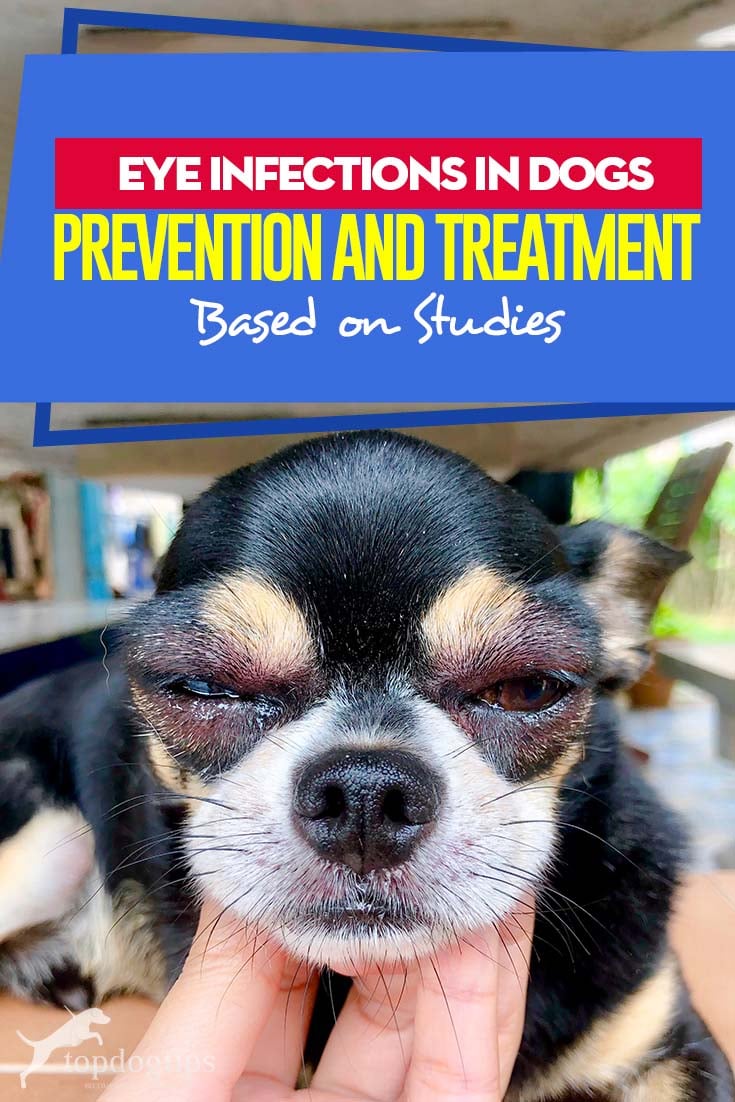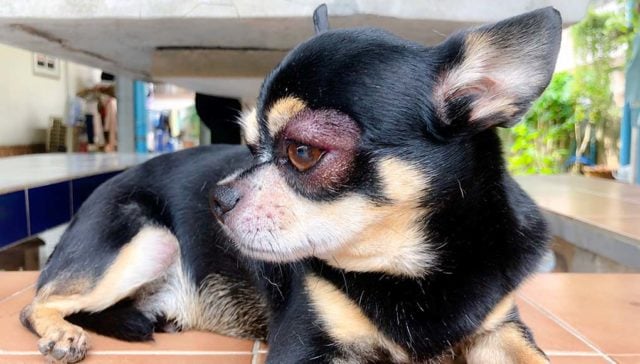
KEY TAKEAWAYS:
– Dog eye infection is pretty common but requires vet diagnosis to specify the cause since most infections have the same signs and symptoms.
– Common causes of dog eye infections are bacteria, viruses, allergies, foreign objects, diseases, etc.
– There are over-the-counter and by-prescription treatments available for home treatment of dog eye infection but consult your vet first.
– Certain breeds are more at risk of developing dog eye infection; prevent them from getting it by regular grooming and cleaning, and giving them healthy food that promotes eye care.
Table of Contents
- How Does a Dog Eye Infection Happen?
- Causes of Dog Eye Infection
- Signs of Eye Infection in Dogs
- Veterinary Diagnosis and Treatment
- Home Treatments for Eye Infections in Dogs
- 5 Ways to Prevent Dog Eye Infections
- Dog Breeds Most at Risk of Eye Infection
- Other Eye Problems in Dogs
- Common Questions of Pet Owners about Dog Eye Infection
- Dog Eye Infection: Before You Go…
Sure, our dogs value their sense of smell, but their sense of sight is equally important to explore and experience the world.
However, dog eye infection is common and can happen to any breed in any environment.
In the worst-case scenario? It can result in blindness when left untreated.
As a veterinarian, I have encountered many cases of eye infection in dogs through the years. And let me tell you: early diagnosis makes a world of difference when treating a pup successfully.
In this article, let me share with you the common signs and symptoms, treatment options, and preventative measures to keep your Fido's eyes healthy and infection-free.
Jump to a section:
- How a Dog Eye Infection Happens
- Causes of Dog Eye Infection
- Signs of Eye Infection in Dogs
- Veterinary Diagnosis and Treatment
- Home Treatments for Eye Infection in Dogs
- How to Prevent Dog Eye Infection
- Dog Breeds Most at Risk of Eye Infection
- Other Eye Problems in Dogs
- Common Questions of Pet Owners about Dog Eye Infection
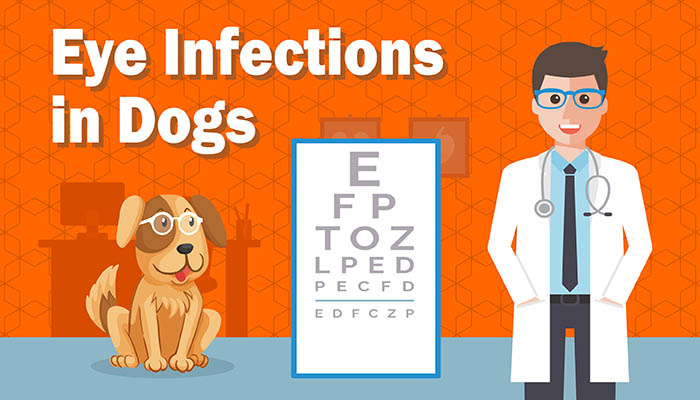
How Does a Dog Eye Infection Happen?
A dog eye infection happens when the eyes react to invasion from harmful micro-organisms: bacteria, viruses, or fungi, among others (1).
Microorganisms can invade all parts of a dog's eye (2).
They are easily eradicated and will cause no permanent damage if action is taken quickly, but preventing this in the first place is always the best step.
Due to a variety of diseases and eye infections in dogs that share similar symptoms, it's difficult to assess the seriousness of the problem before establishing which type of infection it is (3).
Until you know what you are actually dealing with, you won’t know how to treat the problem, never mind how serious it is.
The bottom line is: if you notice something is wrong with your dog’s eyes, schedule an appointment with your veterinarian.
The one thing that all dog eye infection issues have in common is that no matter how bad they might ultimately be, early treatment is almost guaranteed to relieve your dog's suffering quickly and may even save your dog's sight.
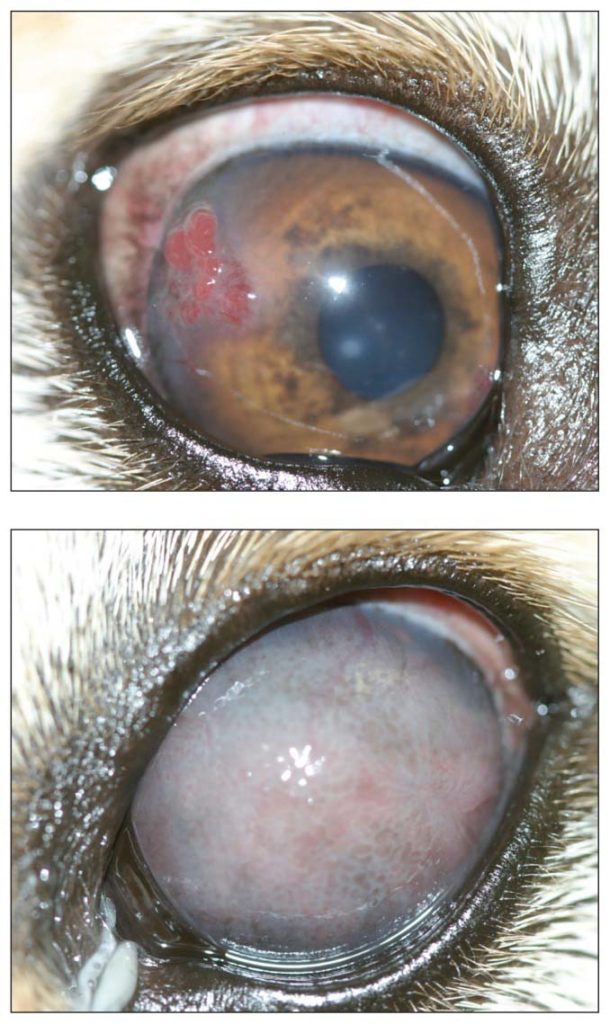
Causes of Dog Eye Infection
There are many ways in which dogs can contract an eye infection:
- Metabolic causes such as diabetes or hyperthyroidism (10, 11)
- Infectious causes like canine distemper virus or leishmania (12, 13)
- Drug-induced with some anesthetics, sedatives, or atropine (14, 15)
- Radiation-induced after treatments for cancer (16).
There are also studies that discovered even more risks for a dog's eyes, such as new dog eye parasites or other related diseases that were previously unknown.
A study in 2016 focused on the mysterious disease related to dog eye infection issues called Sudden Acquired Retinal Degeneration Syndrome (SARDS). This was previously known to vets and pet owners, but we're still unsure of its causes and even proper treatments.
A study in 2017 found that eye infections in dogs can also be caused by newly appearing parasites, and treatments for these can also be complicated.
However, the most common causes of canine eye infections that we know today are:
- pinkeye (conjunctivitis) is the most common cause (17);
- bacteria (of any form) or fungi;
- ulcer/keratitis or corneal infection in the dog's eye;
- several types of viruses (including Herpes);
- glaucoma;
- irritants or foreign material in the dog's eyes;
- Lyme disease.
Regardless of the cause, prompt treatment for an eye infection is essential.
If you fail to prevent any of these eye problems, take your dog to the vet immediately.
Dog eye problems may become chronic or cause lasting damage if not treated right away.
RELATED: 9 List of Dog Eye Problems

Signs of Eye Infection in Dogs
Although canine eye infections are fairly common, the symptoms are shared by many more ominous conditions.
Spend a few moments each day gazing into your pet's eyes – that way, you will be able to identify any changes and treat them at the first opportunity.
General signs of eye infections in dogs could be:
- Excessive amount of tear stains (or epiphora)
- Abnormal discharges in your dog's eyes
- Newly developed extra-high sensitivity to light
- Constant blinking, pawing, scratching at the eyes
- Significant reddening and swelling of the eye area and/or surrounding tissues
- Cloudy or discolored eyeballs
When your dog is suffering from an eye infection, swift actions can ensure the dog doesn’t sustain any lasting damage.
Let me explain in detail some of these signs below:
Discharge from the Eye
Most healthy dogs still have some form of eye discharge, like eye boogers, at some time or another, and that's normal.
But eye discharge becomes a problem when it’s excessive, watery, or pus-like.
It can be caused by allergies, diseases, foreign objects, or acute cases of eye infection.
Avoidance of Bright Lights
Not all dogs long for the bright lights of Broadway, but a healthy dog shouldn’t try to avoid bright lights in general.
Light sensitivity is fairly common when your dog is suffering from irritation to their cornea.
However, there are lots of possible reasons for your dog to avoid the light suddenly, so the sooner you get it checked out, the better.
Change in Blinking
You have to be quite observant to notice this symptom, but just like us, when your pal gets something in their eye, a natural reaction is to blink it out.
The problem is, it might not be a foreign object that's irritating the eye; oftentimes, there can be other explanations, including corneal damage, so check with a vet.
If possible, gently bandage the eye to avoid further irritation caused by the excessive blinking.
Partial Opening of One Eye
The partial opening of one eye is an obvious sign that there is something wrong.
Even the smallest injury can turn into an infected wound, so don’t expect the problem to go away on its own.
You can examine for a foreign object, but the only kind that is safe to handle at home is one where it’s an obvious object and can be flushed out with a saline solution.
All other causes are best examined by your veterinarian.
Veterinary Diagnosis and Treatment
Eye infections have similar symptoms to more serious ailments, and significant damage to a dog's eye can occur quickly.
Vets recommend bringing your dog in within 24 hours if you notice a problem with their eye(s).
You should expect a few tests to be performed to determine the cause of dog eye infection (19).
Examining Your Dog's Eye
If you examine your dog’s eye and can clearly see a foreign body that you can safely remove, it is probably safe to do so; otherwise, leave the exam to the vet.
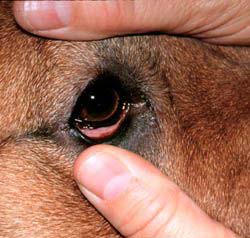
Your vet will want to take your dog's temperature. This is to check for general health and signs of an infection.
They will use an ophthalmoscope and look into a dog’s eyes for tumors, foreign bodies, and any abnormalities.
The vet will note the general health of the eye, including any redness or swelling, discharge, or unusual eye activity.
Testing and Determining the Cause
Your vet will want to run two very straightforward eye tests:
1. Fluorescein test
This test will show the vet if there are any scratches or ulcers on your dog’s eye.
All the vet does is take a chemically treated strip of paper, place it on the dog’s eye, and any problems show up as green, thanks to the chemical Fluorescein.
2. Schirmer tear test
This one says it all in the name; it’s a straightforward and quick test to measure the tear production in your dog’s eye.
It has been used for over a century and is the most standard, best test for many eye problems in dogs (20).
The vet will tell if your pet is producing an average amount of tears or too much or too little due to an infection.
Below are the most common treatments advised by a veterinarian for different dog eye problems, and they should generally not be used by pet owners themselves (21, 22, 23, 24).
Artificial tear drops. The first treatment to use for the relief of the tissue, cornea, conjunctiva, and more. It must be applied regularly and often, depending on the condition.
Acetylcysteine. This is a mucolytic agent often used during the beginning stages of several eye issues in dogs, particularly when eye discharge is noticed and directly linked to a mucin excess on a dog's ocular surface.
Antibiotics. Topical antibiotics are often required for most infections of the eye and most often during the initial phase of treatment to prevent the spread of bacteria.
Corticosteroids. Applied for a brief period, these may improve a dog's eye condition but need to be very carefully used because of the high risk of corneal ulceration. They should not be used long-term for most eye conditions.
Pilocarpine. This treatment is given orally and applied to the dog's eye for specific eye conditions such as keratitis. Once again, this needs to be administered carefully as there are a number of side effects to be expected.
Immunosuppressive drug. Some of these drugs are used alongside tear drops to stimulate tear production in dogs. The most popular are cyclosporine A, pimecrolimus, and tacrolimus.
Surgery is another option for several eye diseases in dogs, depending on the type, severity, how far it progressed, and the current condition of the dog (25).
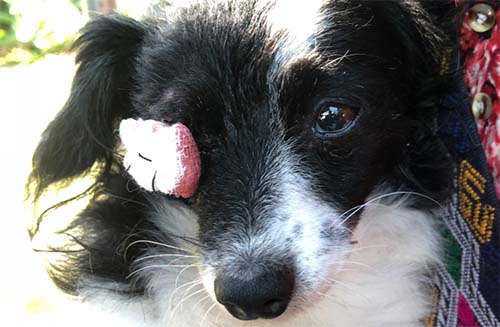
Home Treatments for Eye Infections in Dogs
Eye Drops
Using eye drops is a common way to treat eye infections at home after checking with a vet.
There are three categories of dog eye infection treatments and drops to choose from:
Antibacterial. This is the most common, effective treatment for eye infections. It's available either over-the-counter or with a vet prescription (depending on strength and type) and is generally affordable. It is best to use for a dog's weeping eyes or other insignificant issues.
Petroleum/lubricant. A simple solution, this type of dog eye wash/drops is used for dogs with infected eyes or eye inflammation. It's available over the counter and generally helps with relieving dryness and itchiness.
Steroid. It's the strongest treatment for eye infections in dogs, and it's by veterinary prescription only. Commonly used for serious eye inflammations and other related problems. Often used in conjunction with antibiotics for best results.
Due to their strength and potential side effects, all steroid products must be prescribed by your veterinarian.
You cannot and should not purchase any steroids for dogs yourself.
Topical Ophthalmic Antibiotics
Three new types of topical ophthalmic antibiotics are commercially available, but they need to be prescribed by your veterinarian.
Those are ciprofloxacin, norfloxacin, and ofloxacin. Studies have shown them to be effective for bacterial eye infections (26).
For less severe cases, you can purchase some eye treatments from a store or online retailer without a prescription.
The four most common, best dog eye treatments and lubricants sold over the counter currently are:
| Preview | Product | Rating | |
|---|---|---|---|

|
Vetericyn Plus Ophthalmic Eye Gel for Horses | Eye... | 5,691 Reviews | Check Price |

|
MicrocynAH Ophthalmic Gel | 904 Reviews | Check Price |

|
OptixCare Pet Eye Lube Plus + Hyaluron 20g for Dog... | 7,716 Reviews | Check Price |

|
Miracle Care Cat & Dog Eye Wipes Made In USA, Soft... | 13,050 Reviews | Check Price |
Eye Wash
Two of the most common dog eye washes (non-medical) sold over the counter are:
Tomlyn Sterile Eye Wash  . One of the more popular dog eye washes to buy over the counter, this veterinary-grade dog eye rinse relieves discomfort and itching caused by environmental pollutants.
. One of the more popular dog eye washes to buy over the counter, this veterinary-grade dog eye rinse relieves discomfort and itching caused by environmental pollutants.
It's very sterile and has the same pH level as a dog's tears to avoid any further irritation.
All you need to do is put a few drops of it in both of your dog's eyes to flush out pollutants, dust, mucous, pollen, or any other small objects or allergens.
Nutri-Vet Dog Eye Rinse.  This is another very popular over-the-counter product that helps with reducing redness in a dog's eyes, as well as removing tear stains and debris from around the eyes.
This is another very popular over-the-counter product that helps with reducing redness in a dog's eyes, as well as removing tear stains and debris from around the eyes.
It's a very gentle formulation only suitable for minor eye issues and for simple eye flushing and cleaning, and it will not be suitable for treating serious eye problems in your pet.
While you can also find and buy certain antibiotic dog eye infection treatments over the counter, this approach is not recommended.
It's best to consult with a veterinarian first to choose a plan of action on how you're going to treat your pet and which products to use.
Eyes are very sensitive, and it's crucial to avoid mistakes.
Dietary Adjustments
You can also adjust your pet's diet to further help with healing and treating eye infections.
Things that might help (use in small doses and with caution) include:
- Supplements formulated specifically to strengthen a dog's eyes
- Cod liver oil (¼ to 1 teaspoon)
- Nutrients: Vitamins A, C, or D, zinc, pycnogenols, and bioflavonoids
- Foods that are good for dogs' eyes: blue or purple berries, sunflower and sesame seeds, carrots, parsley and leafy green vegetables
 Dog food supplements like Angels’ Eyes for Dogs are specifically formulated to help dogs with eye problems.
Dog food supplements like Angels’ Eyes for Dogs are specifically formulated to help dogs with eye problems.
This is especially true with bacterial and yeast infections from constantly moist conditions around the eye.
However, eye infection treatment through diet has no scientific backing yet and is mostly based on theory.
When dealing with an actual eye problem, the first thing is to treat the eyes directly.
Be cautious, and consult with your veterinarian before changing your pet's diet.
Other Natural Home Remedies for Dog Eye Infection
Now, if you're more into homemade, natural remedies, there are ingredients around the house or yard you can use to relieve Fido's eye infection.
However, you must take note that not all these options have scientific studies backing their claims. Therefore, caution must still be applied when using them.
I would advise you to consult a holistic veterinarian for a more guided approach to home treatment.
The below home remedies I have included will work for minor issues, but you should see your vet if the condition worsens or persists.
- Saline solution
- Herbal supplements
- Chamomile
- Meadowsweet
- Eyebright
- Burdock
- Rosemary
If your holistic veterinarian gave you a go-signal to do home remedies at home, you can check out our separate article regarding that: My 3 Favorite Dog Eye Infection Home Remedies
5 Ways to Prevent Dog Eye Infections
Preventing eye infections in dogs is not always completely possible.
Sometimes, your dog might come into contact with another dog suffering from an infection and contract it (18).
Other times they might get something in their eye that has bacteria on it, but there are still a few things you can do and some dog eye care products you can use as preventatives.
1. Look Into My Eyes
A good old eye-to-eye chat with your dog is something you can do every morning before your walks.
Become familiar with what your dog's healthy eyes look like so that you will notice anything untoward happening when it does.
2. Road Trip!
When you and your pet go on road trips together, keep the windows closed – seeds, dust, and debris can fly into your dog's eyes.
No more hanging their head out the window with the wind blowing through the dog's fur if you want to avoid all those types of canine eye problems.
3. Scrubadub
Keep your pet's face clean.
Simply get a few washcloths that are specifically your dog's and make it a fun routine.
Use warm water in the winter and cool water in the summer to make your pet feel really pampered.
4. Shave and a Haircut
You don’t need to go so far as a full-on shave, but keeping the hair around your dog's eyes nice and short can stop the hair from scratching your pup's cornea, which can let infection in (here's how to do it).
Or, depending on the length of the dog's coat, maybe buy some scrunchies and tie that hair up.
5. Stick to a Healthy Diet
Your dog needs to be firing on all cylinders to maintain a strong and active immune system to fight off any type of eye infection problems.
A well-balanced diet with all essential vitamins, minerals, and macronutrients is the first step towards that.
Prevention is better than cure, and keeping an eye on your dog's eyes can go a long way in saving you the trouble, time, and money when it comes to dog eye infections.
Dog Breeds Most at Risk of Eye Infection
Almost all dogs can get various infections in their eyes.
Selective breeding of dogs has led to some predispositions or genetic defects, including dog eye infection problems and other issues related to sight.
Below are some of the breeds predisposed to genetic eye problems (4, 5, 6, 7).
Boston Terriers and Other Short-Nosed Dogs
These dogs are more prone to Cherry Eye, a problem of the third eyelid or tear gland.
Luckily, Cherry eye is repairable with surgery or, in some cases, with dog eye drops and gentle eye massage.
Shetland Sheepdogs and other Collie breeds
Shelties, Lassie lookalikes, and Border Collies are prone to what is called Collie Eye Anomaly (CEA).
This is a genetic condition that impacts the retina, choroid, and sclera with varying degrees of severity—from being so mild it doesn’t affect the vision to severe enough that it would lead to a dog's blindness.
English Springer Spaniels
This breed's eyes are not quite as good as their nose. They are very prone to Progressive Retinal Atrophy (PRA), glaucoma, and cataracts.
Be on the lookout for common dog eye infection symptoms such as itchy eyes, cloudiness, or redness.
German Shepherds
Out of all dog breeds, GSDs are the most prone to suffer from Pannus, otherwise known as Chronic Superficial Keratitis (CSK).
This is an affliction whereby the dog’s body suddenly treats the cornea as a foreign object.
Although incurable, its progression can be slowed down and managed (8, 9).
Great Danes
Great Danes are prone to a type of dog eye infection called Entropion.
This is a hereditary disorder where the eyelid rolls inwards, causing the eyelashes to irritate the dog's eye.
It's a painful condition for the pet, which can be remedied by surgery.
Poodles
Poodles are predisposed to suffer from Glaucoma.
This is a condition where there is a buildup of fluid in the eye which causes pressure, pain, and, if not treated early enough, eventual blindness in the dog.
Other Eye Problems in Dogs
Dog eye infections are often confused with a number of other eye problems in dogs.
Below are some of the most common ones, plus their symptoms, that you must know to distinguish which condition your pooch is closer to.
- Cataracts
- cloudy eyes
- blue/white tint
- reduced vision
- increased urination
- Glaucoma
- sore or cloudy eyes
- excessive discharge
- dilated, enlarged pupils
- bulged eyes
- green sheen
- Conjunctivitis
- red eyes
- swollen eyes
- sticky discharge
- pawing at the eye
- Corneal Ulcers
- excessive eye-watering
- a film or cloudiness
- discharge of pus
- excessive squinting
- rapid blinking
- swollen eyes
- Progressive Retinal Atrophy (PRA)
- night blindness
- dilated pupils
- cloudiness
- grey patina
- greenish sheen
- Cherry Eyes
- red eyes
- swollen eyes
- oozing pus
- Allergies
- itchy eyes
- swelling
- red/irritated eyes
- excessively watery eyes
- Entropion
- deformed eyelids
Common Questions of Pet Owners about Dog Eye Infection
Can a dog eye infection heal on its own?
It can be tricky to know if a dog eye infection will clear up naturally or needs vet attention.
A lot depends on what's causing the issue. Sometimes a minor bacterial infection might go away after a few days if caught super early.
Other germs like viruses or fungi really need medication to clear out fully. And you'll want meds from the vet if the infection is deep in the eyeball tissue or the cornea is damaged.
Injuries that lead to red eye also need checking to address the root cause.
While a very mild case may possibly heal on its own, it's usually safer to get professional help when eyes are involved.
Can I give my dog human eye drops?
It's generally not a good idea to use human eye drops in dogs.
While the drops may seem similar, they are actually formulated very differently than drops made for dogs.
Human drops are designed for larger human eyes and often have a higher concentration that could be too strong for a dog's more sensitive eyes.
Not only that, but human drops contain ingredients that may be toxic for dogs.
The drop size and pH level are also tailored specifically for humans. And the dosage amounts wouldn't be the right strength for a dog.
It's best to ask your vet about their recommended eye drops for dogs.
When should I worry about my dog's eye infection?
If you notice any signs of redness, swelling, discharge, squinting, or pawing at the eyes, or if your dog seems to have blurred vision, it's always a good idea to have your vet take a look to evaluate for an eye infection.
You'll especially want to seek veterinary care if the eye infection doesn't seem to be improving after a day or two, as this could indicate a more serious issue.
Other warning signs that an eye infection may need treatment include increased pain behaviors from your dog, the infection spreading to both eyes or if you notice any opacity or ulceration on the surface of the eye.
Ignoring an eye infection runs the risk of it worsening and potentially causing permanent damage, so it's best to play it safe and get your vet's assessment whenever you have any concerns about changes in your dog's eye health.
How long can a dog eye infection last?
The duration of a dog eye infection can vary significantly depending on the underlying cause and severity of the issue.
Generally, mild bacterial infections may clear up within a few days with proper treatment, like antibiotic eye drops prescribed by your vet.
But some infections, like those caused by allergies, viruses, or more serious bacterial infections, could potentially last for weeks.
Without veterinary treatment, certain infections from things like fungi or parasites may persist indefinitely.
Following your vet's advice will help ensure the infection doesn't become chronic or lead to long-term eye problems.
Can dog eye infections spread to humans?
While dog eye infections don't often spread to people, certain bacteria or viruses can be transmitted between dogs and their owners.
Infections caused by bacteria like staphylococcus or streptococcus can potentially spread to humans through direct contact with eye discharge.
Viruses such as herpes virus are also capable of cross-species transmission if the eyes or face come into contact with oral or nasal secretions from an infected dog.
However, the risk of spread is generally quite low if you practice proper hygiene.
To prevent any possible transmission, wash your hands well after touching your infected dog's eyes.
You should also avoid direct contact with the eye discharge as much as you can.
Anyone with compromised immunity or an eye injury should use caution and consult a doctor for guidance if exposure occurs.
With routine hygiene and care, most dog eye infections can be safely managed without human health concerns.
Dog Eye Infection: Before You Go…
Whenever you suspect your dog has an eye infection problem, visit your veterinarian immediately or within 24 hours.
Some conditions may be simple and quick to treat and not pose any danger. Others, however, may be serious and lead to loss of sight and blindness if not promptly treated.
With many dog eye infection home remedies, over-the-counter eye washes/drops, and prescription-based medical treatments available, problems with your dog's eyes can be resolved quickly and leave no lasting problems.
Do not attempt to figure out a treatment plan for yourself because it's easy to make a mistake and make your pet's condition worse.
Always consult with a vet beforehand.
Want to learn more about dog eye care and treatment? Check out our recommended reads below!
Related Articles:
- How to Clean a Dog’s Eye Infection?
- How To Apply Eye Ointment To A Dog
- 9 Scary but Treatable Dog Eye Problems You Should Know About
Disclosure: We may earn affiliate commissions at no cost to you from the links on this page. This did not affect our assessment of products. Read more here and find full disclosure here.



![Dog Eye Infection - Prevention and Treatments [Infographic] Dog Eye Infection - Prevention and Treatments [Infographic]](https://topdogtips.org/wp-content/uploads/2018/02/Dog-Eye-Infection-scaled.jpg)
